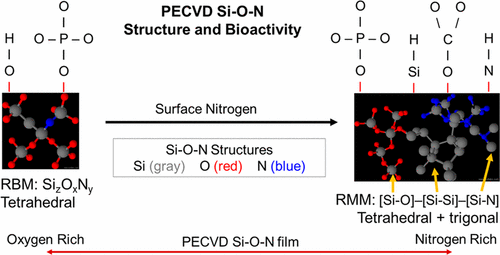当前位置:
X-MOL 学术
›
J. Phys. Chem. B
›
论文详情
Our official English website, www.x-mol.net, welcomes your feedback! (Note: you will need to create a separate account there.)
Role of Hydrogen and Nitrogen on the Surface Chemical Structure of Bioactive Amorphous Silicon Oxynitride Films
The Journal of Physical Chemistry B ( IF 3.3 ) Pub Date : 2017-09-14 00:00:00 , DOI: 10.1021/acs.jpcb.7b05885 Venu G. Varanasi 1 , Azhar Ilyas 2 , Megen F. Velten 3 , Ami Shah 3 , William A. Lanford 4 , Pranesh B. Aswath 3
The Journal of Physical Chemistry B ( IF 3.3 ) Pub Date : 2017-09-14 00:00:00 , DOI: 10.1021/acs.jpcb.7b05885 Venu G. Varanasi 1 , Azhar Ilyas 2 , Megen F. Velten 3 , Ami Shah 3 , William A. Lanford 4 , Pranesh B. Aswath 3
Affiliation

|
Silicon oxynitride (Si–O–N) is a new biomaterial in which its O/N ratio is tunable for variable Si release and its subsequent endocytotic incorporation into native hydroxyapatite for enhanced bone healing. However, the effect of nitrogen and hydrogen bonding on the formation and structure of hydroxyapatite is unclear. This study aims to uncover the roles of H and N in tuning Si–O–N surface bioactivity for hydroxyapatite formation. Conformal Si–O–N films were fabricated by plasma-enhanced chemical vapor deposition (PECVD) onto Ti/Si substrates. Fourier transform infrared spectroscopy (FTIR) and Rutherford backscattering spectrometry (RBS) analysis indicated increased Si–H and N–H bonding with increased N content. Surface energy decreased with increased N content. X-ray absorbance near edge structure (XANES) analysis showed tetrahedral coordination in O-rich films and trigonal coordination in N-rich films. O-rich films exhibited a 1:1 ratio of 2p3/2 to 2p1/2 electron absorbance, while this ratio was 1.73:1 for N-rich films. Both Si and N had a reduced partial charge for both O- and N-rich films, whereas O maintained its partial charge for either film. O-rich films were found to exhibit random bonding SizOxNy, while N-rich films exhibited random mixing: [Si–Si]–[Si–O]–[Si–N]. Thus, hydrogen bonding limits random nitrogen bonding in Si–O–N films via surface Si–H and N–H bonding. Moreover, increased nitrogen content reduces the partial charge of constituent elements and changes the bonding structure from random bonding to random mixing.
中文翻译:

氢和氮在生物活性非晶态氮氧化硅薄膜表面化学结构中的作用
氮氧化硅(Si–O–N)是一种新型生物材料,其O / N比可调节以释放可变的Si,随后将其内吞结合到天然羟基磷灰石中以增强骨骼愈合。然而,氮和氢键对羟基磷灰石的形成和结构的影响尚不清楚。这项研究旨在揭示H和N在调节羟基磷灰石形成的Si–O–N表面生物活性中的作用。保形的Si–O–N膜是通过在Ti / Si衬底上进行等离子增强化学气相沉积(PECVD)制成的。傅立叶变换红外光谱(FTIR)和卢瑟福背散射光谱(RBS)分析表明,Si-H和N-H键合随N含量的增加而增加。随着N含量的增加,表面能降低。X射线吸收率近边缘结构(XANES)分析显示,富含O的薄膜具有四面体配位,富含N的薄膜具有三方配位。富含O的薄膜的1:1比例为2p3/2至2p 1/2电子吸收率,而富氮薄膜的电子吸收率是1.73:1。对于富含O和N的薄膜,Si和N均具有降低的部分电荷,而对于任一薄膜,O均保持其部分电荷。富O膜表现出无规键合Si z O x N y,而富N膜表现出无规混合:[Si–Si] – [Si–O] – [Si–N]。因此,氢键通过表面Si-H和N-H键限制了Si-O-N膜中随机的氮键。此外,增加的氮含量降低了构成元素的部分电荷,并使键合结构从无规键合变为无规混合。
更新日期:2017-09-15
中文翻译:

氢和氮在生物活性非晶态氮氧化硅薄膜表面化学结构中的作用
氮氧化硅(Si–O–N)是一种新型生物材料,其O / N比可调节以释放可变的Si,随后将其内吞结合到天然羟基磷灰石中以增强骨骼愈合。然而,氮和氢键对羟基磷灰石的形成和结构的影响尚不清楚。这项研究旨在揭示H和N在调节羟基磷灰石形成的Si–O–N表面生物活性中的作用。保形的Si–O–N膜是通过在Ti / Si衬底上进行等离子增强化学气相沉积(PECVD)制成的。傅立叶变换红外光谱(FTIR)和卢瑟福背散射光谱(RBS)分析表明,Si-H和N-H键合随N含量的增加而增加。随着N含量的增加,表面能降低。X射线吸收率近边缘结构(XANES)分析显示,富含O的薄膜具有四面体配位,富含N的薄膜具有三方配位。富含O的薄膜的1:1比例为2p3/2至2p 1/2电子吸收率,而富氮薄膜的电子吸收率是1.73:1。对于富含O和N的薄膜,Si和N均具有降低的部分电荷,而对于任一薄膜,O均保持其部分电荷。富O膜表现出无规键合Si z O x N y,而富N膜表现出无规混合:[Si–Si] – [Si–O] – [Si–N]。因此,氢键通过表面Si-H和N-H键限制了Si-O-N膜中随机的氮键。此外,增加的氮含量降低了构成元素的部分电荷,并使键合结构从无规键合变为无规混合。



























 京公网安备 11010802027423号
京公网安备 11010802027423号